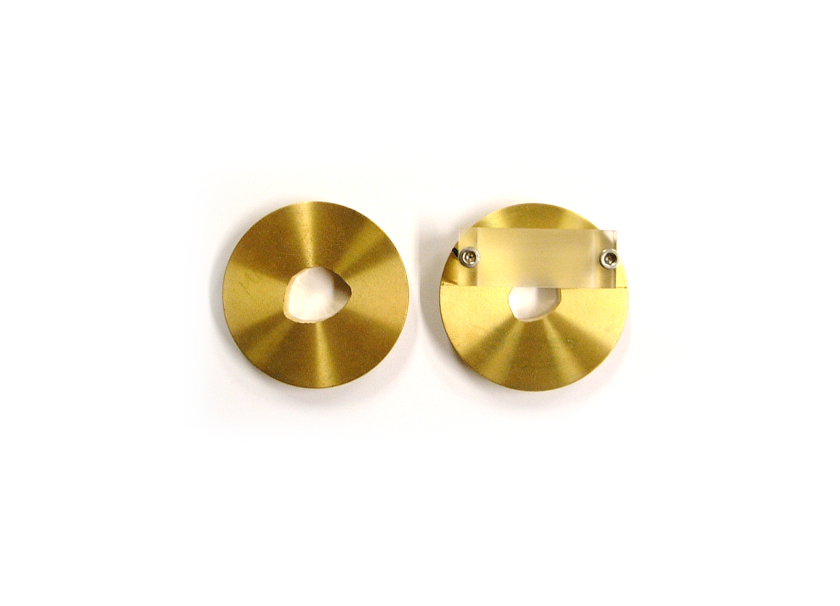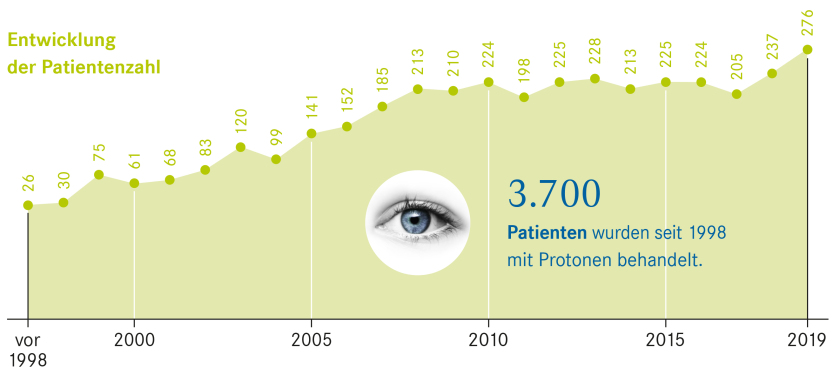20 percent more patients were treated with proton therapy in 2019

An individual eye shield is made for each patient to protect the surrounding tissue from the proton beam. © HZB

Number of patients who received the proton therapy offered jointly by Charité and HZB. © HZB/J. Politt
For more than 20 years, Charité - Universitätsmedizin Berlin and the Helmholtz-Zentrum Berlin (HZB) have jointly offered the irradiation of eye tumors with protons. In 2019, more patients were treated in Berlin-Wannsee than ever before. 276 patients - 20 percent more than in the previous year - underwent proton therapy. The treatment is specialized in choroidal melanomas of the eye. The proton accelerator at HZB is the only treatment facility for this disease in Germany.
500 to 600 people in Germany are affected by a malignant choroidal melanoma every year. In 97 percent of cases, the tumour can be completely destroyed by irradiation with protons. In most cases, not only the eye but also the vision can be maintained to a satisfactory degree. "The energy of the proton beam can be adjusted in such a way that practically only the tumor receives the radiation. Since the protons have a straight trajectory, the lateral scattering is much less than with X-rays," explains Dr. Jens Heufelder, the senior medical physicist at Charité - Universitätsmedizin Berlin. The protons effectively destroy the tumor, while the surrounding healthy tissue is largely spared.
To cope with the increase in patients in 2019, treatment operations at the proton accelerator have been extended to 12 hours. Approximately 45 percent of the patients came from the Berlin-Brandenburg region, the other patients came from other German states and other European countries (approximately 8 percent). The youngest patient who received proton therapy at HZB in 2019 was 8 years old, the oldest patient 96 years old. The average age was 61 years.
Since 1998, more than 3,700 patients have been treated with protons from the HZB accelerator. "The success of proton therapy is based on the collaboration between ophthalmologists, medical physicists and accelerator experts. As a result, the therapy has been continuously improved for the benefit of patients over the past few years", explains Prof. Dr. Andrea Denker, head of proton therapy at HZB.
(sz)
https://www.helmholtz-berlin.de/pubbin/news_seite?nid=21122;sprache=en
- Copy link
-
Battery research with the HZB X-ray microscope
New cathode materials are being developed to further increase the capacity of lithium batteries. Multilayer lithium-rich transition metal oxides (LRTMOs) offer particularly high energy density. However, their capacity decreases with each charging cycle due to structural and chemical changes. Using X-ray methods at BESSY II, teams from several Chinese research institutions have now investigated these changes for the first time with highest precision: at the unique X-ray microscope, they were able to observe morphological and structural developments on the nanometre scale and also clarify chemical changes.
-
Hydrogen: Breakthrough in alkaline membrane electrolysers
A team from the Technical University of Berlin, HZB, IMTEK (University of Freiburg) and Siemens Energy has developed a highly efficient alkaline membrane electrolyser that approaches the performance of established PEM electrolysers. What makes this achievement remarkable is the use of inexpensive nickel compounds for the anode catalyst, replacing costly and rare iridium. At BESSY II, the team was able to elucidate the catalytic processes in detail using operando measurements, and a theory team (USA, Singapore) provided a consistent molecular description. In Freiburg, prototype cells were built using a new coating process and tested in operation. The results have been published in the prestigious journal Nature Catalysis.
-
Rutger Schlatmann re-elected as ETIP PV Chair
The European Technology and Innovation Platform for Photovoltaics (ETIP PV) was created by the European Commission in order to promote photovoltaic technologies and industries in Europe. Now, the ETIP PV Steering Committee elected a new Chair, as well as two Vice-Chairs for the term 2024 – 2026. Rutger Schlatmann, head of the division Solar Energy at the HZB, and professor at HTW Berlin, was re-elected as the ETIP PV Chair.
